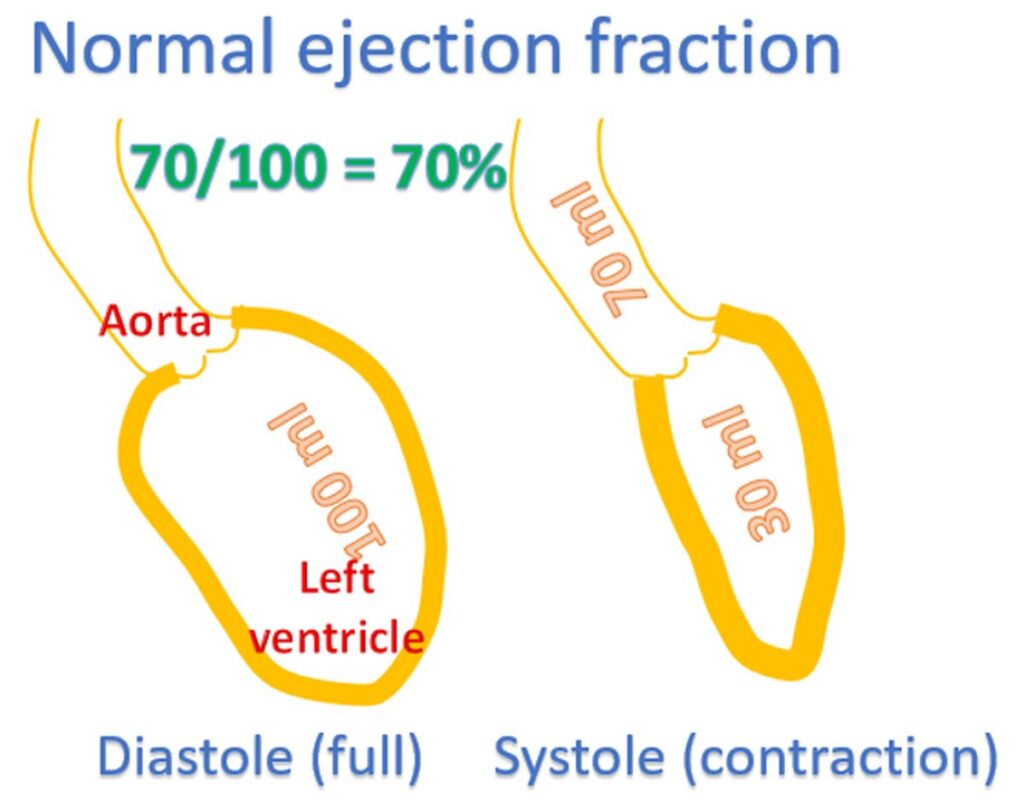What is heart failure with preserved ejection fraction?
What is heart failure with preserved ejection fraction?
To put it simply, heart failure is the inability of the heart to function well to meet the needs of the body. When the heart is not able to pump out enough blood it is known as heart failure with reduced ejection fraction. Ejection fraction is the fraction of the blood ejected out from the filled heart. The lower chambers of the heart fill when they relax after a contraction. As an example, if left ventricle, the lower left chamber, has 100 ml blood after filling and 70 ml is ejected out during the next contraction, the ejection fraction is 70%. In heart failure with reduced ejection fraction, it is below 40%. Some persons have a stiff left ventricle due to disease, which cannot relax and fill well. They have a normal ejection fraction, typically above 50%. This is heart failure with preserved ejection fraction in simple terms.

When the heart is unable to relax well and fill properly, filling pressures rise in an attempt to maintain a good output. This means that pressure in the left ventricle when it relaxes is higher. A higher pressure in the left ventricle is transmitted back to the left atrium, the upper chamber from which it receives blood when it relaxes. A rise in left atrial pressure is in turn reflected on to the pulmonary veins, which bring oxygenated blood to the left atrium from the lungs. Increase in pressure in the pulmonary veins increases the pressure in the small blood vessels of the lungs known as capillaries.
The lung capillaries line the tiny airspaces of the lungs known as alveoli, where carbon dioxide is removed from the blood and oxygen taken up. When pressure in the lung capillaries rise, fluid from blood move out of the capillaries into the alveoli. When the alveoli are flooded with fluid, they are unable to exchange oxygen for carbon dioxide and person becomes breathless. This situation is known as pulmonary edema. The oxygen saturation in blood falls and this can be very serious.
Heart failure with reduced ejection fraction and heart failure with preserved ejection fraction are almost equally common. Heart failure with preserved ejection fraction is more common in older persons as the left ventricular wall becomes stiffer as age advances. Heart failure with preserved ejection fraction is often associated with multiple other diseases which are common in the elderly. High blood pressure, diabetes, obesity, atrial fibrillation (fast irregular rhythm of upper chambers), diabetes, disease of blood vessels of the heart, chronic kidney disease, chronic obstructive lung disease and obstructive sleep apnea (stoppage of breathing due to obstruction of airways in sleep) are some of these. These conditions also have a role in causing heart failure with preserved ejection fraction.
Symptoms of heart failure with reduced ejection fraction and heart failure with preserved ejection fraction are similar. In both there can be breathlessness, initially on effort and later at rest, as the disease progresses. Fluid can collect under the skin of the legs and in the tummy in very late stages. Weight gain occurs when extra fluid is retained in the body, though in late stages weight may come down due to poor food intake and wasting of muscle mass. Poor appetite can occur due to collection of fluid in the inner lining of the stomach. Blood vessels in the neck become enlarged due to back pressure from the heart. Extreme fatigue is common in severe heart failure.
Treatment of heart failure with preserved ejection fraction is primarily by controlling the associated diseases mentioned initially. Cautious use of medications which increase the urine out may be useful. If too much of these are given, as they lower the filling pressure of the left ventricle, its output might fall, causing a fall in blood pressure and giddiness. This is more likely to occur when one stands up suddenly and can even result in a fall and consequent injuries. Some new medications have also been shown to be effective for treatment of heart failure with preserved ejection fraction recently. In general results of treatment of heart failure with preserved ejection fraction is less satisfactory than heart failure with reduced ejection fraction. This could be partly because of the older age and multiple associated illnesses which take their own toll.



